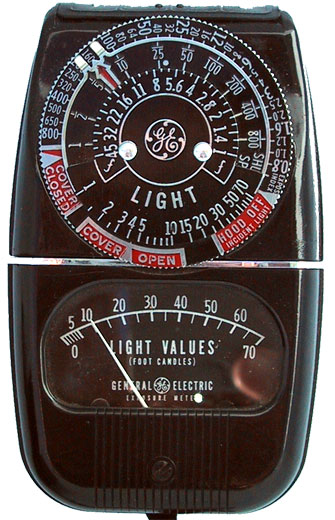|
s.jpg) My first meter (as opposed to my father's). Picked it up at a swap meet with a box of
misc accessories (old sync cords, filter adapters, rubber lens hoods, flash bulbs—the fun stuff)
for little or nothing. This is a pre-war meter—at least pre-war design.
You can generally tell post-war meters by their use of ASA speeds. Prior to the war meters had to use
various other competing schemes for rating film speed, and GE had their own system. My first meter (as opposed to my father's). Picked it up at a swap meet with a box of
misc accessories (old sync cords, filter adapters, rubber lens hoods, flash bulbs—the fun stuff)
for little or nothing. This is a pre-war meter—at least pre-war design.
You can generally tell post-war meters by their use of ASA speeds. Prior to the war meters had to use
various other competing schemes for rating film speed, and GE had their own system.
A couple of nifty things about this. One is that you can use it a couple different ways; if you
pop the hood off it you can use it as a reflected (I think incident if you aim it at the light source),
meter under moderate light, or you can leave the hood on and flip the cover open for restricted
angle reflected or bright light, or you could flip the cover closed (which still had slits in it) for
really bright light. A calculator dial on the back of the hood allowed you to interpret the meter
reading depending on which configuration you used.
s.jpg) The other really nifty thing was that the meter reads off in foot candles—something
only the high-end professional meters tend to do. Most meters simply have an unmarked
match-needle system, or the range is marked off in the maker's own scheme. Foot candles
actually mean something, and can be converted into exposure values if you have the charts.
One of Ansel Adams most famous photographs, "Moonrise, Hernandez New Mexico," was exposed
without a meter because Adams had memorized the luminance of the Moon in foot-candles, and
noodled out the shutter and diaphram combination he needed from there. The other really nifty thing was that the meter reads off in foot candles—something
only the high-end professional meters tend to do. Most meters simply have an unmarked
match-needle system, or the range is marked off in the maker's own scheme. Foot candles
actually mean something, and can be converted into exposure values if you have the charts.
One of Ansel Adams most famous photographs, "Moonrise, Hernandez New Mexico," was exposed
without a meter because Adams had memorized the luminance of the Moon in foot-candles, and
noodled out the shutter and diaphram combination he needed from there.
GE must have sold a gazillion of these because I see them fairly often.
Despite the fact they look as antiquated as they are, they're only worth a few dollars.
|




s.jpg)
s.jpg)